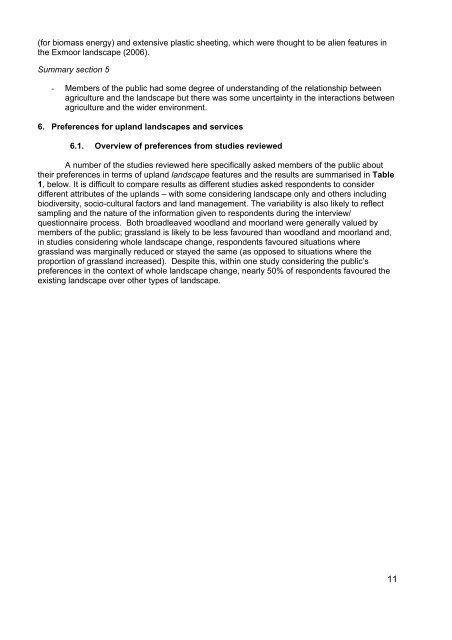Public Attitudes and Preferences for Upland Landscapes - Defra
Public Attitudes and Preferences for Upland Landscapes - Defra
Public Attitudes and Preferences for Upland Landscapes - Defra
You also want an ePaper? Increase the reach of your titles
YUMPU automatically turns print PDFs into web optimized ePapers that Google loves.
(<strong>for</strong> biomass energy) <strong>and</strong> extensive plastic sheeting, which were thought to be alien features in<br />
the Exmoor l<strong>and</strong>scape (2006).<br />
Summary section 5<br />
- Members of the public had some degree of underst<strong>and</strong>ing of the relationship between<br />
agriculture <strong>and</strong> the l<strong>and</strong>scape but there was some uncertainty in the interactions between<br />
agriculture <strong>and</strong> the wider environment.<br />
6. <strong>Preferences</strong> <strong>for</strong> upl<strong>and</strong> l<strong>and</strong>scapes <strong>and</strong> services<br />
6.1. Overview of preferences from studies reviewed<br />
A number of the studies reviewed here specifically asked members of the public about<br />
their preferences in terms of upl<strong>and</strong> l<strong>and</strong>scape features <strong>and</strong> the results are summarised in Table<br />
1, below. It is difficult to compare results as different studies asked respondents to consider<br />
different attributes of the upl<strong>and</strong>s – with some considering l<strong>and</strong>scape only <strong>and</strong> others including<br />
biodiversity, socio-cultural factors <strong>and</strong> l<strong>and</strong> management. The variability is also likely to reflect<br />
sampling <strong>and</strong> the nature of the in<strong>for</strong>mation given to respondents during the interview/<br />
questionnaire process. Both broadleaved woodl<strong>and</strong> <strong>and</strong> moorl<strong>and</strong> were generally valued by<br />
members of the public; grassl<strong>and</strong> is likely to be less favoured than woodl<strong>and</strong> <strong>and</strong> moorl<strong>and</strong> <strong>and</strong>,<br />
in studies considering whole l<strong>and</strong>scape change, respondents favoured situations where<br />
grassl<strong>and</strong> was marginally reduced or stayed the same (as opposed to situations where the<br />
proportion of grassl<strong>and</strong> increased). Despite this, within one study considering the public’s<br />
preferences in the context of whole l<strong>and</strong>scape change, nearly 50% of respondents favoured the<br />
existing l<strong>and</strong>scape over other types of l<strong>and</strong>scape.<br />
11
















